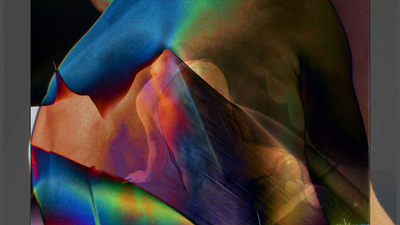UMMA's 'Photoformance' installation finds several top talents exploring notions of 'skin'

Untitled photograph by Ernestine Ruben, part of the "Photoformance" installation
“Photoformance: An Empathic Environment” at the University of Michigan Museum of Art’s Irving Stenn Jr., Family Project Gallery isn’t slowing down its phantasmagoria any time soon.
This audacious multimedia production melds the talents of U-M alum photographer Ernestine Ruben; Monica Ponce de Leon, dean of the U-M Taubman College of Architecture and Urban Planning; Peter Sparling, U-M professor of dance, choreographer, and video artist; and Erik Santos, director of the U-M Electronic Music Studio. “Photoformance” combines all these sources into a seamless artful investigation of the human skin that challenges its viewer’s imagination.
As the UMMA gallery statement, “The supple, sensual environment (these artists) create together” features “a video synthesis of photographic imaging and the choreography of actual bodies projected onto the skins of a multilayered, membrane-like structure, providing a walk-through body, an interactive site for live dance, music and poetry, and a luminous web for visitors to explore.”
“Photoformance’s” imaginative environment in the UMMA’s Project Gallery most certainly does all that—and, perhaps, even a little bit more.
As Carole McNamara, senior UMMA curator of Western art, says in her gallery statement, “From the beginning, the human form provided the shared point of departure for each of the artists. The concept of ‘skins’—both as the body’s single largest and most familiar organ, but also as a living, porous landscape for experience—was a key component; an environment onto which opaque layers, like membranes, can be projected, peeled away, and revealed.”
Three 10-foot-plus gracefully tapering “multilayered, membrane” structures created by Ponce de Leon sit in the heart of the gallery. And it wouldn’t be inaccurate to say this contribution crafts the installation’s overall ambiance, because this trio of diaphanous chambers invites us to immerse ourselves in the installation through participation. On the other hand, as McNamara also notes, “Ruben photographed Sparling dancing in a series of still photographs, which the dancer then ‘reanimated’ by combining the still images into a series of videos. These images of the human form are then further transformed by melding those images of Sparling dancing in Ruben’s rippling reflections of light.”
The installation’s video component (running approximately 20 minutes) is divided into two halves titled “Long Lie Down” and “Tumble.” And the photographic images—three series of visuals video projected about the darkened gallery titled “Dancing Veils,” “Dancing Veils/Dancing Bodies,” and “Phantoms”— shift about slowly, focusing on the human body in boldly expressionist patterns of opulent color and sinuous black and white.
Six video monitors flicker Ruben’s photographs across Ponce de Leon’s arches, tossing about reflective sheens resembling the rush of blood running through the structure’s veins. Navigating these vaguely triangular-shaped geometric rafting certainly creates a distinctive sort of performance art.
Using dissolves rather than the more common animated motion gives each of these video transitions considerable power. By allowing each photographic image to have its unique integrity, Sparling heightens the psychological tension of Ruben’s exploration of supple form. And these videos’ slow bleed gives the installation an equally profound transition on Ponce de Leon’s “skin.” All this happens against the haunting ambient strains of Santos’s music—a significant treat in its own right; as well as reason alone to visit. Thus “Photoformance” becomes a immersive three-dimensional experience that’s simultaneously played out in aural, visual and physical space.
Tthis real-time aesthetic amalgamation contributes to an extraordinary experience. Using its creators’ strengths of dance, photography, music, architecture, and video to craft a sophisticated study of the human form, the installation delves into different dimensions of what we usually think of as only the surface of our being.
It’s not too much to say that the integrated arts of “Photoformance” show us there’s a lot more to being skin deep than we might ordinarily think.
“Photoformance: An Empathic Environment” will continue through May 15 at the University of Michigan Museum of Art, 525 S. State St. Museum hours are 10 a.m.-5 p.m. Tuesday-Saturday; and noon-5 p.m. Sunday. For information, call 734-763-UMMA.

